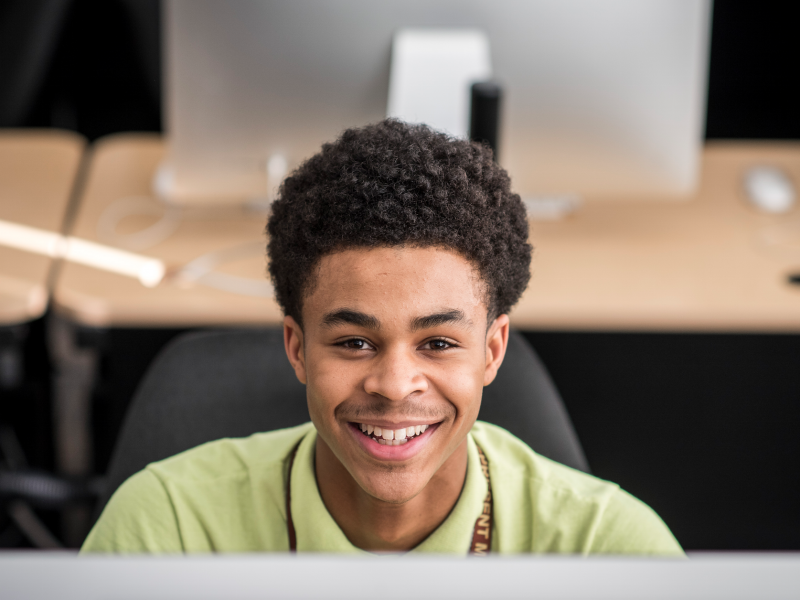8 Employability Skills That Prepare High Schoolers for the 21st Century Workforce

The goal of Career and Technical Education (CTE) is to provide students with hands-on, technical training that prepares them for the rapidly evolving 21st-century workforce.
While technical skills and subject-specific knowledge are important to employers, employability skills are essential to students’ professional development. Employability skills are the core, transferrable skills that are needed in nearly every job—such as conflict resolution, communication, and professional etiquette.
“Employability skills are as critical to getting a job as anything students could learn in the classroom,” said Dave Curry, Milton Hershey School Director of Career and Technical Education. “Teaching these skills in the classroom and providing authentic work experiences where they can implement what they learned is very important to their development.”
To prepare high school students to succeed in the workforce after graduation, take a look at some of the foundational employability skills Milton Hershey School is incorporating into its CTE curriculum.

What Are Employable Skills?
Employable skills are the abilities and competencies that enhance an individual’s prospects of securing and maintaining employment. These job skills are essential for performing tasks effectively in the workplace and can be divided into two main categories: hard skills and soft skills.
Hard skills are specific, teachable abilities that can be defined and measured, such as proficiency in programming languages, accounting, or data analysis. These skills are often acquired through education or training and are typically job specific. In contrast, soft skills refer to interpersonal qualities that enable individuals to interact effectively with others. Examples include communication, teamwork, problem-solving, and adaptability. While hard skills may get a candidate in the door, soft skills often determine their success in the workplace.
In today’s competitive job market, possessing a well-rounded set of employable skills is more important than ever. Employers are increasingly looking for candidates who not only have the technical knowledge but also the ability to collaborate, think critically, and adjust to changing environments. The rise of automation and technological advancements has further underscored the need for continuous learning and skill development. At Milton Hershey School, we recognize the significance of nurturing these employable skills in young people, ensuring they are well-prepared for the challenges of the modern workforce.
Core Employability Skills
When students learn how to conduct themselves in the 21st-century workforce, they will be equipped to succeed in a broad range of careers—not just their field of interest. Start by teaching some of these core employability skills:
- Conflict resolution – The skill of effectively addressing disagreements and finding mutually beneficial solutions is crucial in maintaining a harmonious work environment.
- Accepting criticism – Being open to feedback demonstrates a willingness to learn and improve, which employers highly value.
- Working with a team – Collaboration fosters innovation and enhances productivity, making teamwork an invaluable skill.
- Workplace etiquette – Understanding the norms and expectations of a workplace helps individuals navigate their environment more effectively.
- Proper use of workplace electronics – Proper use of workplace electronics is increasingly important in our digital age, as it ensures efficient communication and task completion.
- Interviewing skills – Knowing how to present yourself confidently and answer questions thoughtfully can set you apart from other candidates.
- Resumé writing – Crafting an effective resume is an art that requires attention to detail and the ability to highlight your strengths and experiences succinctly.
- Workplace communication – Clear and effective communication is key to preventing misunderstandings and fostering positive relationships among colleagues.
Developing these employable skills can greatly increase your child’s employability and prepare your child for a successful career.
How to Develop Employability Skill Lessons
As students develop their employability skills, it’s helpful to provide them with opportunities to apply their knowledge in real-world settings. Whether it’s guest speakers, internship and co-op programs, or mock phone calls to local professionals, the following ideas can help students understand the importance of an employability skillset.
Skills-Based Competitions

Encourage students to participate in local or nationwide competitions, such as SkillsUSA, that focus on career exposure and preparation. When students test their skills in real-world, high-pressure environments, they become passionate about getting better and develop an appreciation for hard work.
Active Listening

Ask students to sit with their backs to each other. One student will give directions and guide their peers step by step to create a drawing. Without looking at the drawing, students will learn how to actively listen and give clear, effective directions.
Role Playing

Create cards that list different scenarios and comments. After choosing a card, students must model specific behavior to appropriately respond to the card’s positive or negative comments while the rest of the class evaluates whether their response was effective.
Mock Phone Calls

Work with a local company that is willing to participate in a cold-calling activity. Then, assign students the task of making mock phone calls to the company’s employees with the goal of closing the sale. Afterward, the professionals can provide feedback on students’ communication skills and teach them about sales techniques. Students will not only learn the fine balance of communicating and listening, but they also will learn how to research and prepare for a presentation.
To be successful in the 21st-century workforce, students need more than technical skills. They need to know how to be empathetic leaders, savvy communicators, and effective collaborators.
These employability skills span every classroom and every career field, making them an essential component of our Career and Technical Education program at Milton Hershey School.

